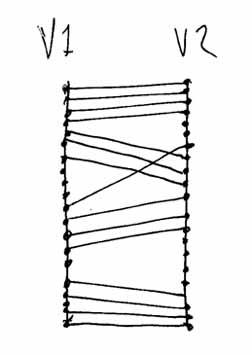
The problems of the World Wide Web, which we foresaw--
Like the Turing machine, xanalogical structure is an abstract idea which
needs to be understood as a point of reference. And, even retrofitted
to the Internet, it should provide a powerful remedy to the ills that now
beset us.
THE FUNDAMENTAL VISUALIZATION OF XANADU
To understand this picture fully is basically to understand what xanalogical structure is about.

One person's overall work and a specific article
All the media in the world, and a specific collection
Each line between the two versions shows an element which is the same, so the element is actually shown by both the line and the dots at its ends.
This indicates *transclusion*, the visible identity of an element which is in more than one place..
Maintaining and showing transclusions is the heart of xanalogical structure.
While links-- connections between things which are different-- has always been a part of the structure, they are not shown here to emphasize transclusion.
Xanalogical systems can be made large-grain or fine-grain.
LARGE-GRAIN XANALOGICAL SYSTEMS
Both the original xanalogical system (zipper lists, 1965) and the most recent design (ZigZag) are large-grain.
In a large-grain xanalogical system, the elements in the illustration represent chunks-- paragraphs, sentences or cells.
FINE-GRAIN XANALOGICAL SYSTEMS
Xanalogical systems still under development (xoc86, xoc92 and OSMIC)
are fine-grain. In a fine-grain xanalogical system, the elements
are text characters, individual audio samples and video frames.